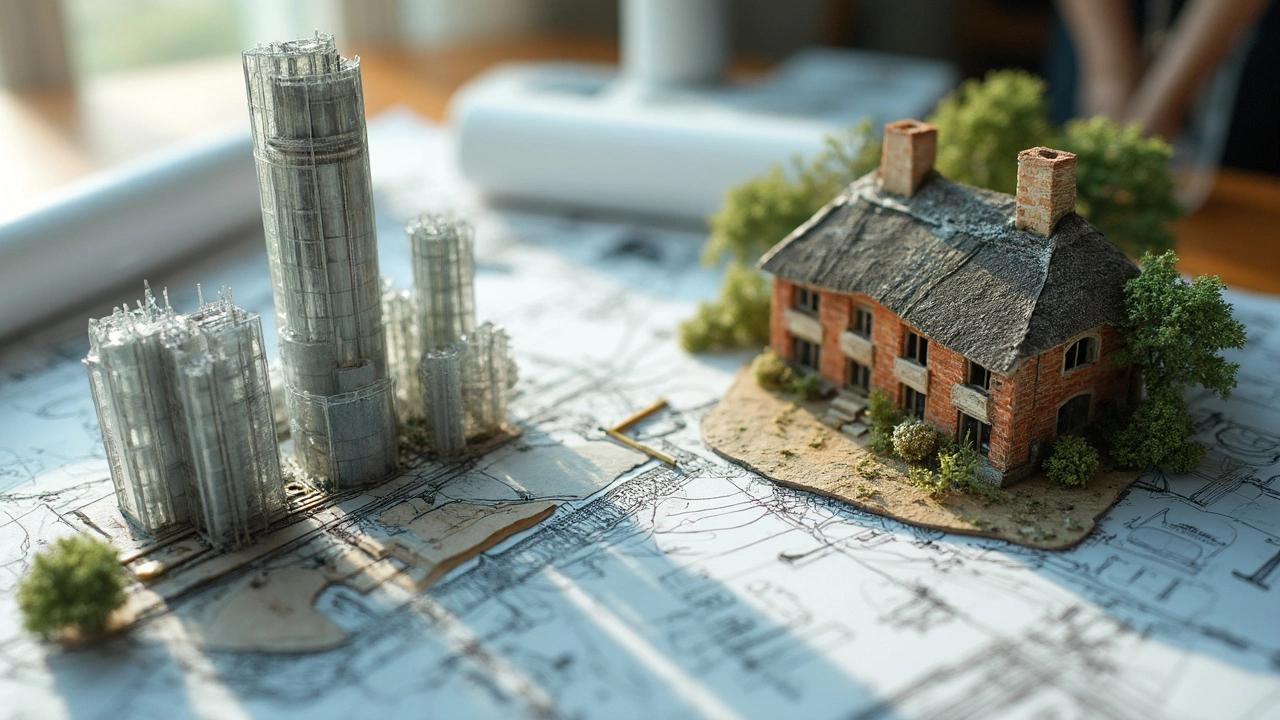So, you're pondering whether commercial or residential construction is your thing? Let's break it down. Commercial construction usually involves big projects like office buildings, shopping malls, or hotels. Think large-scale, often high-risk, but potentially high-reward. On the flip side, residential construction is all about homes—from single-family units to apartment complexes. More personal, maybe less daunting, but also with its own set of challenges.
The choice largely comes down to your goals, resources, and maybe even where your passions lie. It's important to recognize what you're getting into, especially when it comes to costs and potential payoffs. Commercial jobs might mean deeper pockets but also deeper dives into project management and compliance. Residential projects can be more manageable but often come with tighter budgets and personal client interactions.
- Understanding the Basics
- Cost Considerations
- Scope and Scale
- Future Opportunities
- Practical Tips for Decision-Making
Understanding the Basics
When stepping into the world of construction, it's crucial to know the lay of the land. Let's strip it down to the essentials: commercial construction revolves around developing properties like shopping centers, office buildings, and industrial facilities. These projects often require massive budgets, rigorous planning, and compliance with complex regulations. On the other hand, residential construction is what builds homes, whether it's cozy single-family houses or sprawling apartment complexes.
Here's a mind-blowing fact: in 2024 alone, Canada spent over $100 billion on construction projects, with a substantial chunk going into the non-residential side. That tells you just how big this sector is! Understanding these basic differences gives you a head start and allows you to anticipate which challenges and opportunities you might face.
"The difference lies primarily in the scale and complexity of projects," says Thomas Clarke, director of a leading construction firm. "In commercial construction, every decision cascades into many others, demanding intense coordination."
Each sector has its unique flavor. Commercial construction means juggling tenants, clients, and often the public. There's teamwork on a grand scale. Meanwhile, residential work might involve more direct client interaction, especially if it's about custom homes. The path you choose guides how you plan, manage, and deliver each project.
So, if you're eyeing a start or a career shift in the construction industry, grasping these distinctions is the key. It's not just about the nuts and bolts but about aligning with where you see yourself—whether that's creating bustling commercial hubs or crafting the places people call home.
Cost Considerations
Understanding the costs in both commercial construction and residential construction can make or break your project. When diving into commercial projects, expect higher upfront costs. These include not just the materials and labor, which are often more expensive due to the scale, but also permits, insurance, and potential zoning fees.
A key point in commercial projects is the financing. Companies often rely on investors or loans to fund these big ventures. Profits can be alluring, but getting there is a monetary marathon, not a sprint. As John Smith, a leading construction analyst, aptly puts it:
"In commercial construction, the scale of investment is heavy, but so can be the returns. It's a game for those with deep pockets and big dreams."
Residential projects, on the other hand, typically require less capital up front. But don't be fooled by the seemingly lower costs. Factors such as customized designs, client changes, and varied site conditions can quickly add up. Plus, dealing with individual homeowners might mean more careful planning to avoid budget overruns.
Here's a quick look comparing some typical cost differences between the two:
| Cost Factor | Commercial Construction | Residential Construction |
|---|---|---|
| Architect Fees | 5-20% more | Standard fees |
| Project Size | Larger scale, higher cost | Smaller scale, lower cost |
| Permits and Approvals | More complex, higher cost | Simpler, lower cost |
Considering these facts, whether you're building a high-rise or a dream home, keeping an eye on budget details from the start is crucial. It's always wise to have a buffer for unexpected expenses, regardless of project type. Measure twice, cut costs once, right?
Ultimately, both realms require careful financial planning, but the stakes and approaches differ. Your best bet is to get a clear estimate and a thorough understanding of all potential expenses before putting on that builder's hard hat.

Scope and Scale
When it comes to scope and scale in construction, the differences between commercial and residential projects can be quite striking. Let's paint the picture clearly. Commercial construction often involves bigger budgets and more significant timelines. We're talking about multi-story buildings or sprawling malls that can take years to complete. Because of this, the planning phase usually needs detailed design, permits, and coordination among a massive team of architects, engineers, and contractors.
On the other hand, residential projects are generally more straightforward but come with their own set of demands. Creating homes can range from cozy bungalows to entire apartment complexes, but even the largest residential developments usually don't match the scale of commercial undertakings. Construction can be quicker, and there’s often a more personal touch with homeowners involved in decisions to a higher degree.
- Commercial projects can scale up to include hundreds of thousands of square feet, requiring complex infrastructural considerations that residential buildings often don’t need.
- Residential spaces may focus more on aesthetics, comfort, and livability, appealing directly to end-users who plan to live in these spaces daily.
- In terms of regulations, commercial projects face stricter zoning laws and safety standards, mostly due to public access and usage.
Here's a quick glance at some differences in scale:
| Type | Average Project Size (sq ft) | Average Completion Time |
|---|---|---|
| Commercial | 50,000+ | 1-5 years |
| Residential | 1,500 - 50,000 | 6 months to 2 years |
Recognizing these differences can help you position yourself better in the industry. Are you a fan of big, challenging tasks with the commercial tag, or do you prefer tailored experiences that residential projects bring? Knowing where you feel most comfortable can give your construction career clear direction.
Future Opportunities
Thinking ahead about where the construction path can lead is just as crucial as jumping on a project today. When it comes to commercial construction, the opportunities often grow alongside urban development. As cities expand, there's a constant demand for new office spaces, retail outlets, and entertainment hubs. This means job security and a steady stream of projects if you're in the right place at the right time.
Looking at residential construction, trends are shifting hugely. More folks are working remotely, and that means a rising interest in homes that include office spaces. Plus, the move toward sustainable and eco-friendly living spaces is picking up steam, providing a niche for builders to explore. Families are looking for efficient homes, while developers are prioritizing green building practices.
Here's something that might surprise you: the global construction market, including both commercial and residential sectors, is expected to reach over $15 trillion by 2025. The rising population and urbanization are two big drivers of this growth.
Need a tip for future-proofing your career in this industry? Consider specializing in a specific area, like sustainable construction practices or tech integration in building. Both are set to become more prevalent as technology advances. Being known as the go-to expert in a niche can secure your spot in a competitive market.
- Dive into new technologies like Building Information Modeling (BIM) which offers great efficiencies and chances for innovation.
- Keep an eye on local policies and incentives for green building projects—they could open up new pathways for business.
- Networking is golden. The more connections you build with clients, suppliers, and partners, the more chances you'll have to discover unseen opportunities.
Whatever path you choose, whether it's commercial construction or residential construction, each sector is filled with its own set of exciting future prospects. Understanding these can go a long way in maximizing both your impact and income in the industry.

Practical Tips for Decision-Making
Choosing between commercial construction and residential construction is no small feat, but a few key pointers can definitely help steer the ship. It’s all about asking the right questions and considering crucial factors.
1. Understand Your Market: A common starting point is analyzing demand. If your area is booming with businesses, commercial might be the way to go. But if there’s a housing shortage, residential projects could offer better opportunities. Check local construction trends to see who’s building what.
2. Evaluate Your Resources: Think about budget, manpower, and timeline. Commercial projects often require larger teams and longer commitments. They also tend to need more capital upfront. Residential jobs, while smaller, still require a solid financial plan and reliable team, especially if you’re juggling multiple projects at once.
3. Assess Your Risk Tolerance: Commercial jobs come with bigger risks but also bigger rewards. Are you ready to handle potential complications with zoning laws or long-term financing? Residential projects might feel less risky but don’t underestimate the challenges of meeting specific client needs or the unpredictability of the housing market.
4. Consider Future Opportunities: Look at where you want to be in five or ten years. Commercial work could open doors to prestigious projects or partnerships, yet residential could lead to a steady stream of reliable work with room for creative designs and personal client connections.
5. Lean on Technology: Use the latest project management tools or construction software to stay efficient. For instance, Building Information Modeling (BIM) can help visualize projects, plan out materials, and prevent costly mistakes in both commercial and residential construction. It’s a game changer when managing complex plans.
| Consideration | Commercial | Residential |
|---|---|---|
| Team Size | Large | Small to Medium |
| Risk Level | High | Medium |
| Project Duration | Long-term | Short to Medium-term |
By taking these factors into account, you’ll be better equipped to decide whether to dive into the world of commercial skyscrapers or charming homes. Ultimately, the best choice hinges on what aligns with your professional goals and available resources.




